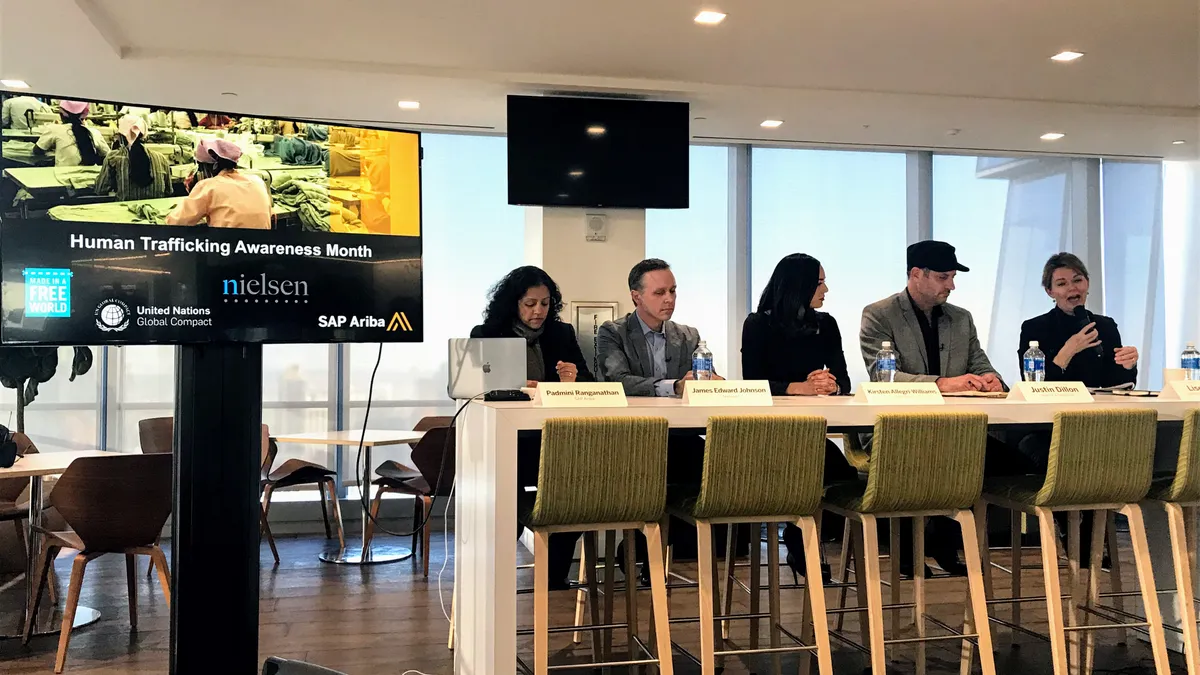The coffee bean farmer in Southeast Asia and the consumer buying coffee beans at the local supermarket in Washington D.C. are oceans and continents apart. But thanks to technology, these two people have never been closer, despite the miles that separate them physically.
When the supply chain becomes more transparent, it's easier to see not only a company's supplier, but the supplier's supplier and so on, down several tiers.
But ignorance is bliss, and with visibility comes risk. When companies explore the depths of their supply chains, there is the potential to find undesirable labor conditions — anything from forced or child labor to hazardous working conditions to violations of workers' rights.
Slavery is a profit-generating business
More than 40 million people worldwide are victims of forced labor, according to data from the International Labor Organization, and about half of those forced laborers are children. Supply chain software company SAP Ariba estimates the collective forced labor workforce generates $150 billion in profits in the U.S. annually.
Just in the past two years, investigations have found human rights abuses in the supply chains of fashion retailers, such as ASOS, Marks & Spencer and Uniqlo. Another probe revealed Turkish textile factories forcing children under age 10 to work 60-hour weeks.
It doesn't matter how far down in the supply chain you are. You're going to feel the impact of this.

James Edward Johnson
Director, Supply Chain Risk Management and Analytics, Nielsen
As organizations nationwide commemorate National Human Trafficking Awareness Day, there’s never been a better time for managers to take a closer look at ethics in their supply chains. At SAP Ariba, it's referred to as "procurement with purpose."
“This is the perfect moment to set a new and fresh agenda for businesses,” said Lise Kingo, CEO and executive director of United Nations Global Compact.
Kingo named climate change and social equality as some of the biggest challenges for companies.
"Decent work in the supply chain is definitely an area where the world needs to do much, much better," she said.
How to turn information into action
Companies are recognizing the problem; the challenge is how to take action. The task can be especially difficult for smaller companies with limited resources.
"There’s perfection, and there’s progress. This is a process," said Justin Dillon, founder and CEO of Made in a Free World, which develops supply chain transparency tools such as FRDM. "Companies focus on how little power we have. Look at the power we do have, and leverage that power."
This underscores the importance for smaller companies to diversify their vendors as much as possible, James Edward Johnson, director of supply chain risk management and analytics at Nielsen, told Supply Chain Dive. Cutting ties with a bad supplier is easier to swallow if the company can turn to other existing sources.
While it may be a difficult move up front, dropping a supplier is critical in the long run to brand reputation.
"It doesn't matter how far down in the supply chain you are. You're going to feel the impact of this," Johnson said. "Maybe you can get away with it for a few years, but eventually, consumers are going to start to take notice."
The technology solution
A consumer push for sustainable and ethical sourcing has already driven companies to adapt. Some have used technologies such as cloud computing or decentralized systems to track data on the supply chain.
Unilever, for example, is using blockchain to trace labor and ethics issues on its tea supply chain.
Blockchain, however, has its limitations, said Padmini Ranganathan, vice president of products and innovation at SAP Ariba.
"How far do you go down the tracking system [with blockchain]? It's very easy to say, ‘we're going to use blockchain’ — but how?" Ranganathan told Supply Chain Dive. "Blockchain only works if there's information in it."
Obtaining that information is as much a challenge as sorting through the noise and itemizing critical data. SAP Ariba is working on a data capture with "waste pickers," who sort through plastic before it's recycled.
"The information captures goes all the way from waste picker, to segregation, to quality metrics," Ranganathan said. "We’ve already enabled them on our network to bring that info and profile it."
Another technology application stepping up to the plate is a software platform called FRDM, which allows companies to monitor and itemize the risks in their supply chain beyond tiers one and two.
For example, a manager can select a specific product, and FRDM will flag potentially high-risk suppliers.
Managers and workers share responsibility
Detecting labor violations in the supply chain isn't limited to managers. Many workers have access to anonymous complaint hotlines. The fishing industry, Ranganathan said, has installed complaint systems on mobile devices.
Reaching a slave number of zero is a long-term goal — and not a goal that can be achieved in the vacuum of the supply chain.

Supply Chain Dive
Adidas has established hotlines available to thousands of workers in Asian factories, where they can report violations through text messages and smartphone apps.
The company’s modern slavery evaluation program focuses specifically on monitoring second-tier suppliers and subcontractors.
Last year, UPS worked with non-profit Truckers Against Trafficking to train drivers to spot human trafficking.
Managing change beyond the supply chain
Reaching a slave number of zero is a long-term goal — and not a goal that can be achieved in the vacuum of the supply chain. Societal and political changes will have to occur to eradicate modern slavery.
When consumers demand fast fashion at a cheap price, sometimes the suppliers have no choice but to acquiesce if they want to remain in the marketplace. On the flip side, consumer preference for ethical products can shift company priorities.
"The buyer and seller take that joint accountability to make a difference," Ranganathan said.























